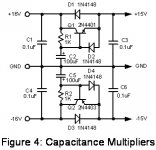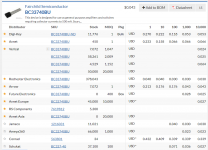Hello,
I'm thinking of implementing the cap multipliers from Bob Cordell's VinylTrak along with a SMPS for low-power circuits like headphone amps.
This is the link: http://www.cordellaudio.com/preamplifiers/vinyltrak.shtml
And the schematic:

My question is how much current is this capable of delivering? Will one of these be suitable for powering 4 op amps?
I'm thinking of implementing the cap multipliers from Bob Cordell's VinylTrak along with a SMPS for low-power circuits like headphone amps.
This is the link: http://www.cordellaudio.com/preamplifiers/vinyltrak.shtml
And the schematic:

My question is how much current is this capable of delivering? Will one of these be suitable for powering 4 op amps?
Transistors in the schematic are rated at 600mA max collector current, so I would assume it will happily drive 4 op-amps.
how much current is this capable of delivering? Will one of these be suitable for powering 4 op amps?
Yes, it should handle over 100mA easily.
Please note that in this schematic, C5 is backwards in polarity.
Last edited:
> how much current is this capable of delivering?
The 1K base resistor and transistor hFE gives emitter impedance near 10 Ohms.
There's 0.6V of drop built-in the transistor. Added drop due to 10 Ohms:
10mA - 0.1V
100mA - 1V
1A - 10V
There is also dissipation. Even if we tolerated 10V drop at 1A, the resulting 10 WATTs of dissipation would melt the specified transistors. At 100mA we have 0.6V+1V= 1.6V, at 0.1A, is 0.16 Watts in a part rated for 0.6W or more. Amply conservative.
Clearly no-good for 1A. Clearly no-problem at 100mA, which covers a LOT of opamp chips.
The 1K base resistor and transistor hFE gives emitter impedance near 10 Ohms.
There's 0.6V of drop built-in the transistor. Added drop due to 10 Ohms:
10mA - 0.1V
100mA - 1V
1A - 10V
There is also dissipation. Even if we tolerated 10V drop at 1A, the resulting 10 WATTs of dissipation would melt the specified transistors. At 100mA we have 0.6V+1V= 1.6V, at 0.1A, is 0.16 Watts in a part rated for 0.6W or more. Amply conservative.
Clearly no-good for 1A. Clearly no-problem at 100mA, which covers a LOT of opamp chips.
well spotted rayma!
After they blow up in your face a few times, you tend to be careful about these things.
I recommend that you at least consider using the BC327-40 and the BC337-40 transistor types instead. They are rated for 800mA instead of 600mA for the 2N4401. And their DC current gain parameter "Beta" is much much higher, so the voltage dropped across the 1K base resistor will be much much less, so the power dissipation at very high output currents (500mA) will be much much lower.
And since this is a "capacitance multiplier" circuit after all, we should remember that the goal is to have an effective capacitance which is the actual capacitance (C2; 1000uF) multiplied by Beta. The larger the Beta, the greater the multiplication.
Octopart.com says they are available from a multitude of distributors, image below.
_
And since this is a "capacitance multiplier" circuit after all, we should remember that the goal is to have an effective capacitance which is the actual capacitance (C2; 1000uF) multiplied by Beta. The larger the Beta, the greater the multiplication.
Octopart.com says they are available from a multitude of distributors, image below.
_
Attachments
Last edited:
Due to i am looking for much less current around 25mA. I decided to use SMD instead so BC337-40 is not usable for me so i choose higher hfe devices such as BC847C and PMBT6429 but i face with more voltage drop compared with BC337-40 in LTspice.
All comments are welcome.
All comments are welcome.
Hello Mr. Didden i found 2SD2114K looks promising for positive voltage but sadly there no smd equvelent avaliable for pnp (negative voltage). I have common ground switch mode smps output. I guess i will switch to dual secondary linear transformer to use 2SD2114K on both rail.
- Home
- Amplifiers
- Power Supplies
- Cordell capacitance multiplier current capability?
